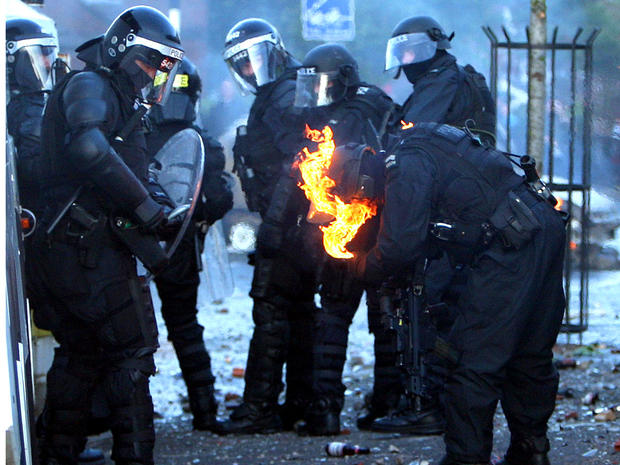Riots in N. Ireland, as old rivalries die hard
BELFAST, Northern Ireland -- Police firing plastic bullets and powerful water cannons forced Catholic militants away from a key Belfast road Tuesday as Northern Ireland's annual day of Protestant marches reached a tense climax.
Catholic youths lashed out at police both before and after the marches by the Orange Order, a Protestant brotherhood whose yearly July 12 demonstrations celebrate 17th-century military triumphs over Catholics -- and often inspire a violent response from the province's minority.
Hundreds of mostly teenage Catholics, who covered their faces with masks and hoods, waged running street battles with heavily girded police on the streets of Ardoyne, a hard-line Irish nationalist enclave in north Belfast.
Police reported standoffs and smaller riots in several other Catholic parts of this British territory, where a 1998 peace accord and 2007 creation of a Catholic-Protestant government have failed to defuse Northern Ireland's summertime tribal clashes over marching rights.
The Ardoyne rioters, cheered by much larger crowds of Catholic spectators, tried to force their way on to the major local road in protest at a peaceful Protestant parade that police had just permitted to pass under strict conditions -- including a requirement that the Protestants march to the beat of a lone snare drum.
The police, determined to prevent direct Protestant-Catholic street fighting, held their ground backed by three massive mobile water cannons that doused street fighters, journalists and spectators alike.
As darkness fell, the rioters reinforced their salvos of firecrackers, rocks, bricks and bottles with gasoline-filled Molotov cocktails. Some burst harmlessly on the sides of police armored vehicles or more alarmingly amid rows of police, who wore helmets and flame-retardant boiler suits. Some rioters shouted "Burn! Burn!" as officers frantically batted out the flames.
Officers responded with dozens of single, targeted shots from plastic-bullet guns designed to knock down individual rioters without seriously wounding them. One rioter was seen trying to throw a Molotov cocktail, only to drop it as his feet when struck by one of the blunt-nosed cylinders.
It appeared certain that the casualty list would surge from Tuesday's earlier total of 24 police officers and an unknown number of rioters. Typically, rioters injured in Belfast avoid hospitals because they face police arrest there.
In the predawn hours before Tuesday's Orange parades, Belfast Catholic youths rioted at three front-line points near Protestant districts. In the worst violence near Northern Ireland's main M1 motorway, rioters hijacked a bus and tried to crash it into police lines but missed and crashed into a sidewalk.
Last year, Catholic clashes with police both before and after the Protestants' traditional July 12 parades ran for three nights and left 83 officers wounded, mostly on the bitterly contested streets of Ardoyne, long renowned as a power base of the outlawed Irish Republican Army.
"The Twelfth" officially commemorates the July 12, 1690, triumph of Protestant King William of Orange versus his Catholic rival for the English throne, James II, at the Battle of the Boyne south of Belfast. Underscoring their devotion to Protestantism and a British identity, the Orangemen march under banners depicting the British crown on an open Bible.
Orangemen once marched wherever they wanted in Northern Ireland, a state created on the back of Orange power as the predominantly Catholic rest of Ireland won independence from Britain in the early 1920s.
Catholic hostility to Protestant parades helped ignite warfare over Northern Ireland's future that claimed more than 3,600 lives from the late 1960s to mid-1990s, when paramilitary cease-fires finally took hold.
As the IRA lowered its guns, Sinn Fein activists began blocking Orangemen's traditional marching routes in several cities, towns and villages. The tactic brought Northern Ireland to the brink of civil war -- and ended in broad defeat for the Orangemen, who refused to negotiate on their marching rights until it was too late.
Britain punished the Orangemen's stubbornness by imposing bans on parades that met the heaviest opposition from Catholics. Orangemen spent years mounting violent standoffs with British security forces in hopes of regaining lost ground, but eventually gave up.
The Crumlin Road beside Ardoyne is the only remaining parading point in Belfast that inspires recurring violence. There, the Orangemen have no obvious alternative way to march from their lodges to central Belfast and back.
In 2005, IRA dissidents opposed to their side's cease-fire first turned Ardoyne into the major July 12 sectarian flashpoint. They hurled homemade grenades at police from Ardoyne shop rooftops, wounding more than 100 officers. On Tuesday, police seized control of those rooftops -- only to see the Ardoyne extremists shift the battleground to a few streets away.
